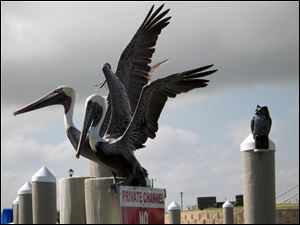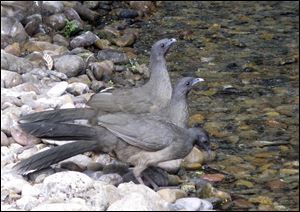
Birding for beginners in South Texas
4/24/2011
The observation tower gives a view of the wetlands and the mile-long boardwalk at the South Padre Island Birding and Nature Center on South Padre, Island, Texas.
Dallas Morning News

Brown pelicans prepare for lift off from a piling on the Brownsville Shipping Channel by South Padre Island, Texas. Behind them is a plastic owl meant to frighten away nuisance birds.
SOUTH PADRE ISLAND, Texas -- This town at the southern end of a slim barrier island that hugs the Texas Gulf Coast from near Matagorda almost to Brownsville is an open-air aviary of known, lesser-known, seldom-seen, Texas-only, shy, raucous, and graceful bird species -- more than 400 visiting or nesting residents, according to the South Padre Island Birding and Nature Center.
So many birds funnel through this area where the Central and Mississippi migratory flyways converge that it's impossible to not see fliers specific to the Rio Grande Valley and others you'd have to travel through several states and Canada to inspect as closely.
Although March to early May are the best weeks for seeing migrants, enough avian visitors spend spring and summer in the area that bird spotting remains good through summer and into the southbound fall migration. Waterfowl gather here in winter.
Without leaving the immediate area, and armed with binoculars and a field guide to birds, it's a cinch to compile a memorable trip list. I did just that over four days on the island and nearby mainland.
Although the Rio Grande Valley has many sites where birders can scan trees, grasses, shrubs, and shores, I limited my treasure hunt to five: beach, a boat ride into South Bay, the Arroyo Colorado river, Laguna Atascosa National Wildlife Refuge, and the boardwalk shared by the South Padre Island Birding and Nature Center and the town's convention center.
Along the nut-brown sands of the beach, palm-size sanderlings ("wave runners") dash to receding water to check for morsels left behind, then dart landward as a new roller flattens onto the beach. Laughing gulls hoot and cackle at hand-holding tourists and fitness enthusiasts pacing the flat miles of sand. Basic-brown willets work the water's edge, tall enough to stalk the shallows and dig for mollusks or crabs. Terns, their black heads looking like well-oiled toupees, jet overhead.

The observation tower gives a view of the wetlands and the mile-long boardwalk at the South Padre Island Birding and Nature Center on South Padre, Island, Texas.
Cruising the bay
Scarlet Colley's Fins to Feathers nature cruise into South Bay pauses at isolated shorelines where privacy-loving plovers, least sandpipers, cormorants, night herons, spoonbills, and more are near enough to the idling boat that it's possible to study their identifying marks. We nose toward a grove of black mangroves where the elusive mangrove warbler has been seen. A canary-yellow bird with a handsome chestnut head and sweet song, it's a relatively new nester along the coast. Serious birders come from far away to see it, and a spotting would be a coup for a beginner. Today it refuses to show itself.
I move from gulf to river on a four-hour cruise on the Arroyo Colorado with Aaron Reed of Kiskadee Charters. Reed knows my heart's desire: to see a great kiskadee, a South Texas flycatcher that also dives for fish. Lemon yellow underneath, reddish brown on wings and tail, with broad black horizontal stripes on its white head, the kiskadee is an eye-catcher. Ear-catching is its loud call, a trumpeted, "Not me!"
Three species of kingfishers (ringed, belted, and green), osprey in trees and overhead, a dervish of gulls whirling above a wharf, the dusky plumage of a green heron, hawks, wild turkeys, and more add to amazements along the river. I spot 53 species.
Climates converge
The 90,000 acres of the Laguna Atascosa refuge, about an hour from the town of South Padre Island, is at the convergence of desert, temperate, coastal, and tropical climates, and the great diversity of bird-life (415 species tallied) and wildlife find niches within the variations. Of the 50 ocelots -- small wildcats -- remaining in the U.S., 20 are on the preserve, according to Sue Woodson, guiding a two-hour tram tour of the 15-mile Bayside Wildlife Drive. She and her husband, Dave, are knowledgeable volunteers, catching the pop-up of bobwhite quail in a bush's low branches and picking out savannah sparrows flitting on a mud bank.

A trio of plain chachalacas drinks at a watering station at the Laguna Atascosa National Wildlife Refuge on South Padre, Island, Texas.
Trails behind the refuge's visitor center offer delights as well, especially in the racketing of garrulous, pheasant-size chachalacas and the loud comments by the green jay, a Ferrari among birds with green, blue, black, and bright yellow feathers. Watchers bring spotting scopes, long-lens cameras, and the naked eye to the trails' watering holes, and all see wonders.
Spotting made simple
The easiest pickings, however, are at the island's birding and nature center and next-door convention center, where a linked mile-long boardwalk meanders over mudflats, by streams, past weedy fields to marsh and sandy shore. Saltwater, freshwater, and brackish water come together here and concentrate the birds.
A curlew, its long bill like a pry bar, levers mollusks from the mud. A white ibis preens with its curved red bill. A spotted sandpiper bobs its backend like a boogie king. A reddish egret stands motionless, a still-life of posture and smoke-and-rust feathers.
The close-ups from the boardwalk hold potential for what some call the "aha!" bird -- the sighting so exciting that it transforms a casual watcher into a birder. South Padre's hundreds of species seem to campaign for the "aha!" title, to be the switch that turns a beginner on for life.